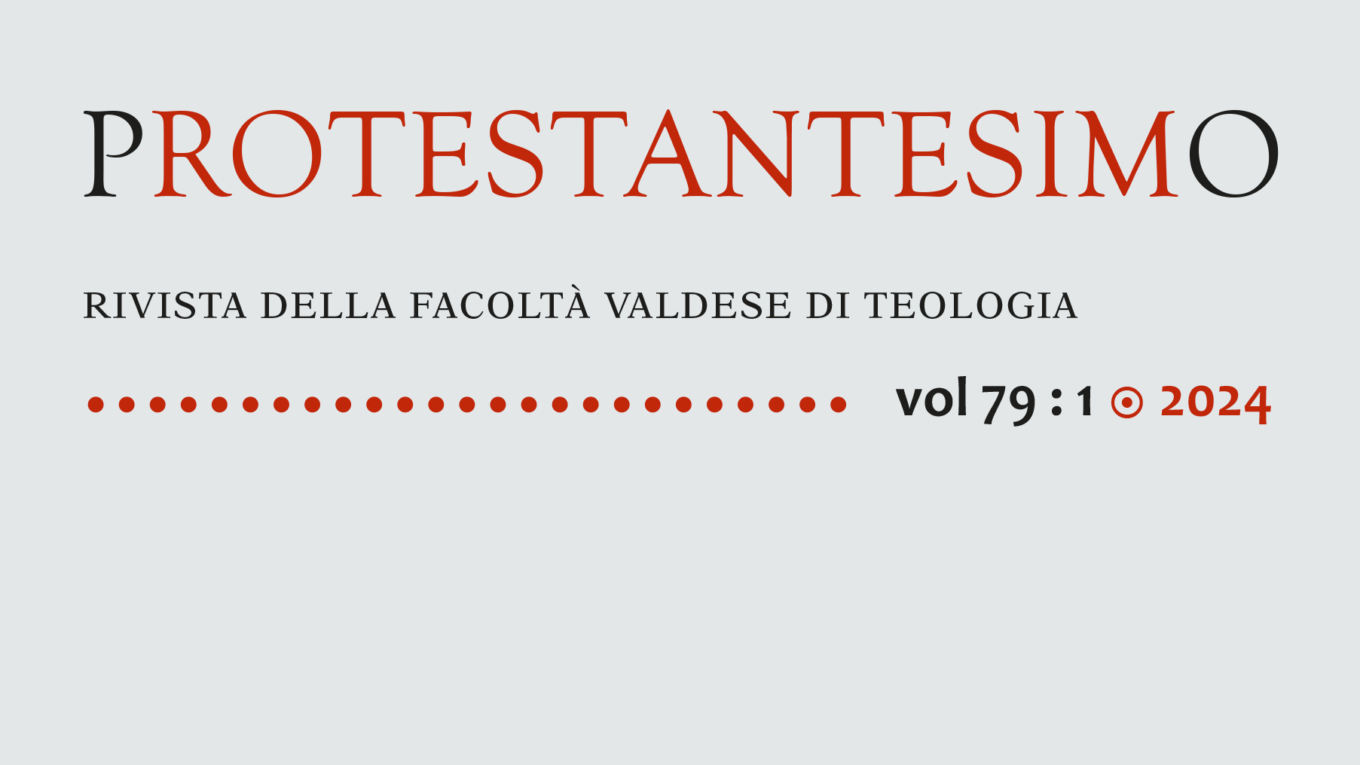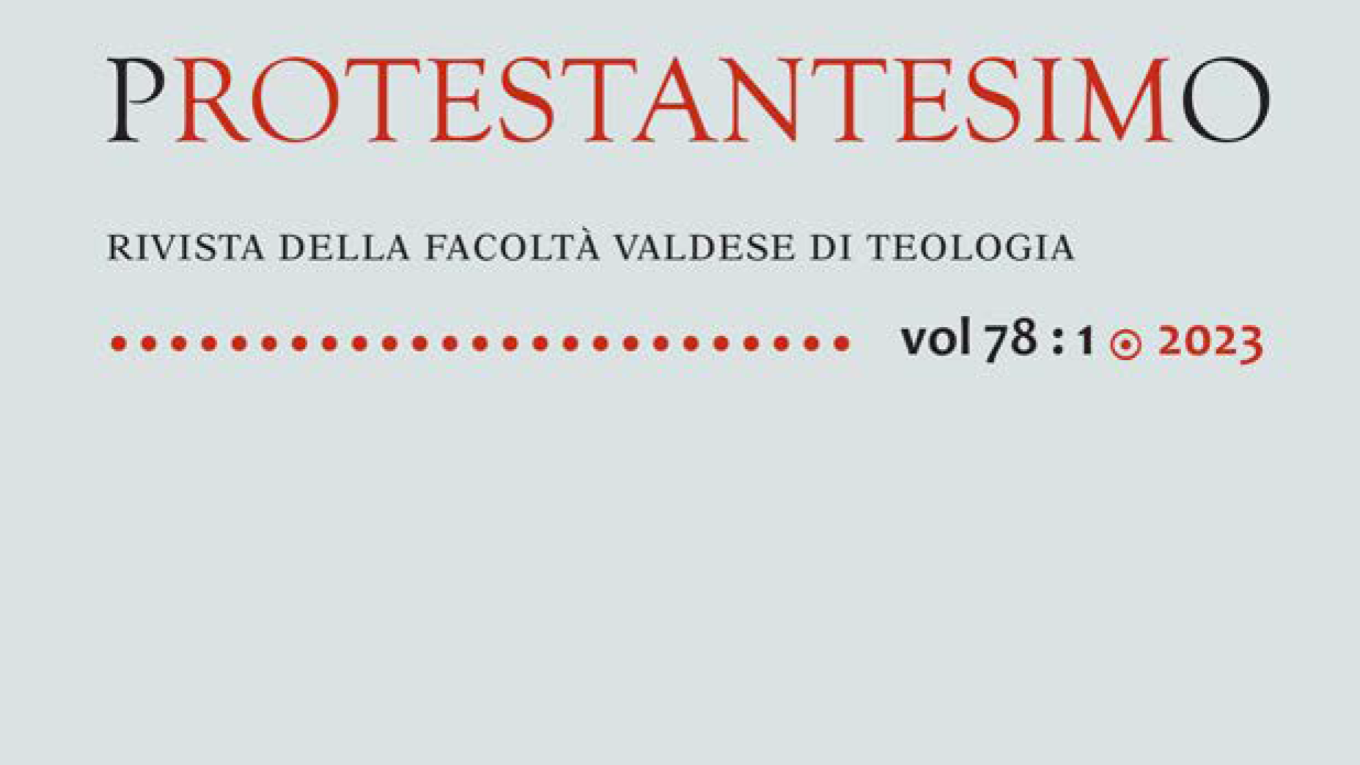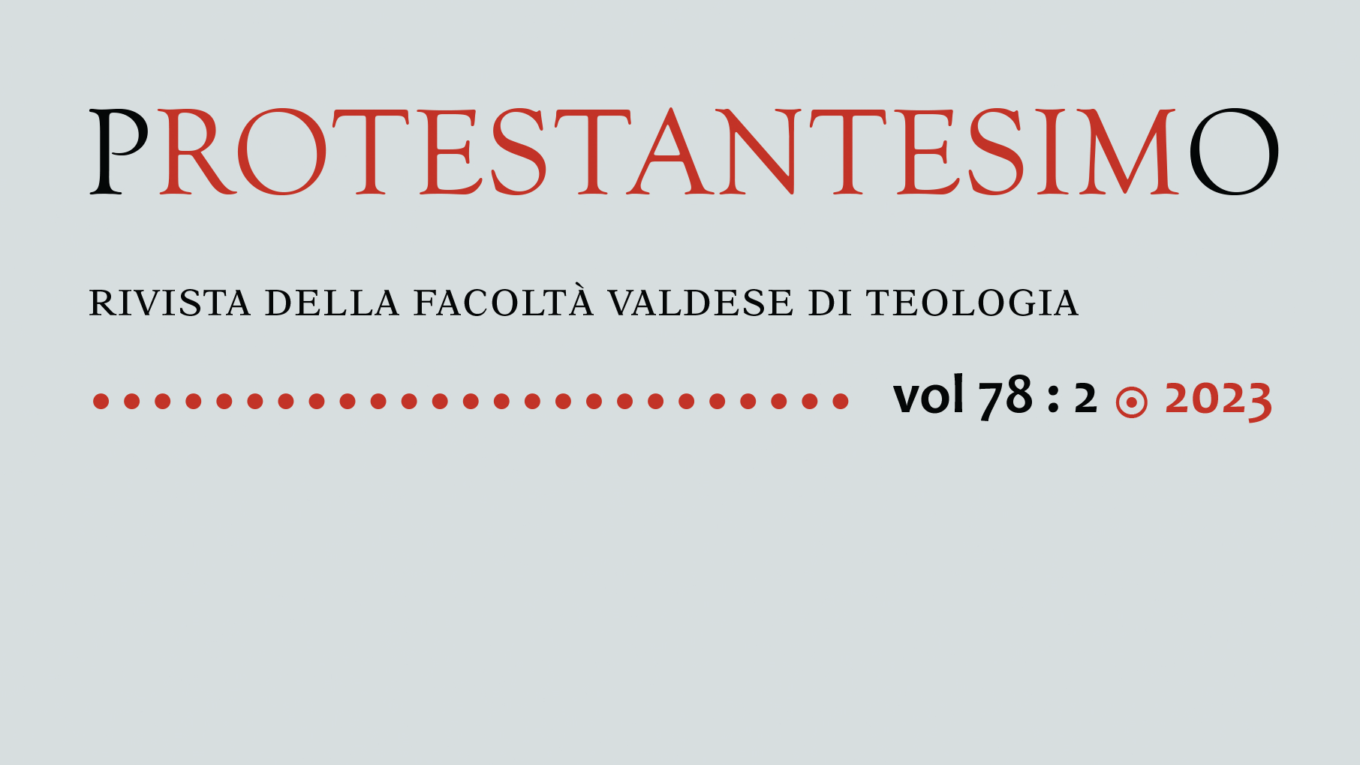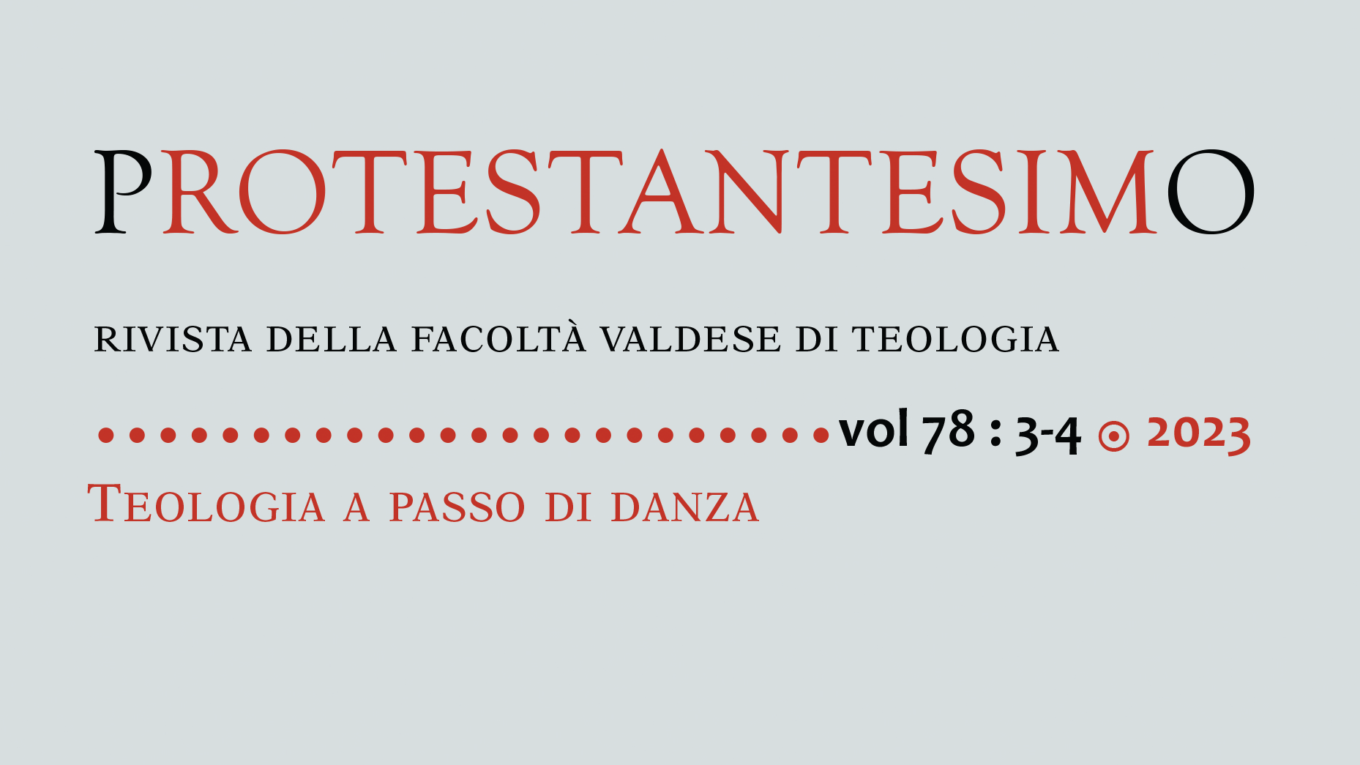Paolo Ricca, Leggere tra le righe della Sacra Scrittura
Questo contributo alla raccolta in onore di Enrico Benedetto rileva la dimensione affettiva di un’esistenza cristiana, circoscritta nei termini di un amore di Dio di cui la figura di Maria si presta come paradigma. Tale esistenza si concretizza nell’imitazione di Cristo e nella memoria delle «misericordie» operate da Dio.
Paolo Ricca, Reading between the Lines of Holy Scripture
This contribution to the collection in honour of Enrico Benedetto highlights the affective dimension of a Christian existence, which is circumscribed in terms of a love of God of which the figure of Mary can be used as a paradigm. This existence is realised in the imitation of Christ and in the memory of the “mercies” operated by God.
Jérôme Cottin, Pour que la théologie pratique devienne poétique et liturgique
Due brevi preghiere pubblicate nel Livre de prières (2008) sono presentate, commentate e contestualizzate. Esse rappresentano l’occasione, per l’autore, di sostenere l’importanza per la teologia pratica di diventare più liturgica e più poetica, il che corrisponde alla «svolta estetica» che si può osservare, da alcuni anni, nella teologia pratica e nella teologia protestante.
Jérôme Cottin, Pour que la théologie pratique devienne poétique et liturgique
Two short prayers published in the Livre de prières (2008) are illustrated, commented and referred to the present in this article. The Author uses them as an occasion to highlight the importance for Practical Theology to become more liturgical and poetic, which is in line with the “aesthetic change” which has lately characterized Practical Theology and Protestant Theology.
Letizia Tomassone, Chi è Lei?
In questo articolo presento un inno scritto da un teologo riformato, Brian Wren, una confessione di fede che presenta D** con immagini e linguaggio femminile. Molte comunità di donne intorno al mondo sono impegnate a trasformare le liturgie delle chiese per dar conto della presenza delle donne e di altri soggetti resi invisibili dalla teologia classica. L’accompagnamento e l’impegno di un uomo come Wren per creare linguaggi e pratiche inclusive nella chiesa non può che rafforzare la costruzione di spazi più giusti e abitabili per tutte le persone che esprimono la loro identità fuori dalle categorie etero-normative e duali del patriarcato.
Letizia Tomassone, Who is She?
In this Article, I introduce a hymn written by a Reformed theologian, Brian Wren, an Affirmation of Faith which introduces G** using feminine images and language. Many communities of women around the world are committed to transforming the liturgies of Churches to take into account the presence of women and other subjects who are kept invisible in traditional Theology. The support and commitment of a man like Wren in creating inclusive languages and practices in the Church, cannot but reinforce the building of more just and habitable spaces for all the persons who utter their identity outside the dual and outside-rules of patriarchy.
Corinne Lanoir, Conversare con Dio da diverse culture
Conoscendo l’interesse di Enrico per gli indiani del Canada, desidero offrirgli qui una preghiera di altri indiani dal sud del continente americano. Presenterò prima questa preghiera fiduciosa al dio creatore dei popoli andini nel contesto dell’«incontro fallito» dei popoli originari del continente con il cristianesimo imposto dai colonizzatori. Accennerò ad alcuni elementi della situazione attuale e proporrò alcune riflessioni sulla possibilità di parlare a Dio con le parole di un’altra cultura.
Corinne Lanoir, Conversation with God in Different Cultures
Knowing Enrico’s interest in Canadian Indians, I would like to offer him a prayer composed by other Indians, of the Southern American continent. I will first present this prayer, composed by the Andean peoples, which is full of con- fidence in god the creator – in the context of the “failed encounter” between the native peoples of the continent and Christianity as imposed by colonizers. I will mention some elements of the present situation and will suggest considering the possibility of talking to God using the words of another culture.
Daniele Garrone, L’empio Manasse, la preghiera a lui attribuita e le sue fortune
Il re Manasse, secondo II Re 21, è certamente un campione di empietà. Il pentimento e la preghiera che II Cronache 33 gli attribuisce sembra attenuare la contraddizione tra la sua impunità empietà e il fatto che il suo sia stato il più lungo dei periodi di regno di Israele Giuda. Tra gli apocrifi dell’Antico Testamento compare anche una Preghiera di Manasse, che ha avuto grande fortuna in ambito cristiano, ma di cui è stata rinvenuta una versione ebraica nella Geniza del Cairo. Ne esiste anche una versione in occitano, circolante tra i valdesi medievali. Tra i Salmi apocrifi di Qumran compare anche un’altra preghiera attribuita a Manasse. Queste brevi note intendono presentare alcune delle tappe e dei testi principali della ricezione della figura di Manasse e della sua preghiera.
Daniele Garrone, Impious Manasseh, the Prayer Attributed to Him and Its Fortunes
King Manasseh, according to 2 Kings 21, is certainly a champion of impiety. The repentance and prayer that 2 Chronicles 33 attributes to him seems to mitigate the contradiction between his ungodly impunity and the fact that his was the longest of Israel-Judah’s reigns. Among the apocrypha of the Old Testament there is also a Prayer of Manasseh, which has had great fortune in Christian Churches, and of which a Hebrew version has been found in the Cairo Geniza. There is also a version in Occitan, which circulated among the medieval Waldensians. Another prayer attributed to Manasseh appears also among the apocryphal Psalms of Qumran. These brief notes aim to present some of the main stages and texts in the reception of the figure of Manasseh and his prayer.
Annegret Reitz-Dinse, Parole che saziano. Salmo 145,15-16, la preghiera tra culto pubblico e spiritualità privata
Il libro dei Salmi nella bibbia è una raccolta di preghiere ebraiche che oltre al loro uso nel tempio a Gerusalemme e nella liturgia ebraica hanno anche giocato un ruolo importante per il culto cristiano. L’esempio del salmo 145, 15- 16 serve a vedere la trasformazione che si è creata con la ricezione all’interno della spiritualità cristiana. Le traduzioni in lingue parlate e le composizioni di musicisti mostrano la ricchezza della cultura protestante europea nella quale l’Italia e la Germania possono guardare a dei legami di scambio culturale veramente fecondi.
Annegret Reitz-Dinse, Satiating Words. Psalm 145. 15-16: Prayer between Public Service and Private Spirituality
The Book of Psalms in the Bible is a collection of Hebrew prayers, which, besides their use in the Temple in Jerusalem and the Hebrew Liturgy, have played an important role in the Christian Service. The example of Psalm 145. 15-16 is useful to point out the transformation, which appeared when it was received within Christian spirituality. The translations in spoken languages and the compositions by musicians show the richness of the European Protestant culture, inside which Italy and Germany can find connections of very fecund cultural exchanges.
Yann Redalié, Cherchez… la prière. Marco 9,14-29
«Questa specie di spiriti non si può cacciare in altro modo che con la preghiera» (Mc. 9,29), così risponde Gesù alla domanda dei discepoli sul perché loro non avessero potuto guarire «il ragazzo tormentato da uno spirito maligno» (Mc. 9,14-29). Eppure, non è con la preghiera che Gesù ha scacciato lo spirito sor- domuto, ma con un esorcismo. Siamo, dunque, rimandati al dialogo centrale e paradossale con Gesù e al grido del padre del ragazzo, che confessa nello stesso soffio la fiducia e la mancanza di fiducia. Fede e preghiera vengono proposte come dialogo di verità, che svela la propria fragilità nel dibattito, in ogni cre- dente, tra fede e incredulità, tra vita e morte, dinanzi a Cristo.
Yann Redalié, Cherchez… la prière. Mark 9.14-29
“This kind can come forth by nothing, but by prayer and fasting” (Mk.9, 29), this is the answer given by Jesus to his disciples’ question – why they were not able to heal the boy “which hath a dumb spirit” (Mk. 9,17). And yet, it is not with prayer that Jesus cast out the deaf and dumb spirit, but with an exorcism. We are, therefore, sent back to the central and paradoxical dialogue with Jesus and to the cry of the boy’s father, who confesses in the same breath his faith and his lack of faith. Faith and prayer are suggested as a dialogue of truth, which re- veals one’s frailty in the debate, of every believer between faith and incredulity, between life and death, in front of Christ.
Eric Noffke, Romani 9,5. Una dossologia cristologica?
In Rom. 9,5 incontriamo una misteriosa dossologia: è rivolta a Dio, come avviene di solito nelle lettere dell’apostolo, oppure a Cristo, che verrebbe allora identificato con Dio? Entrambe le soluzioni hanno dalla loro parte argomenti importanti. Con una preferenza per l’interpretazione cristologica, in questo articolo si recepiscono i risultati di alcuni studi recenti, che sottolineano la fluidità del concetto di monoteismo nel i secolo: la rappresentazione del Dio unico poteva abbracciare in sé anche altre figure, per cui l’affiancamento del Figlio al Padre era concepibile già al tempo di Paolo (I Cor. 8,6). Questa constatazione ci permette una volta di più di ribadire che il movimento di Gesù, ben lungi dal costituire un’anomalia, fu in ogni suo aspetto una forma di mediogiudaismo, tanto quanto il giudaismo rabbinico. Bisogna dunque abbandonare l’idea di una separazione del cristianesimo da una sua presunta matrice, in favore dell’idea di due religioni sorelle, figlie della stessa madre (il mediogiudaismo).
Eric Noffke, Romans 9.5: A Christological Doxology?
In Romans 9.5 we find a mysterious Doxology: it is addressed to God which is typical of the Apostle’s Epistles, or to Christ, who, in that case, would be identified with God? Both solutions are based upon important arguments. This Article prefers the Christological interpretation, basing it upon the results of some recent studies, which highlight the fluidity of the concept of Monotheism in the 1st century AD: the representation of the one God could include also other figures. Therefore, flanking the Son to the Father was conceivable even in Paul’s times (1 Cor. 8.6). This observation enables us to repeat, once more, that Jesus’s movement, far from being an anomaly, was, in every aspect, a form of middle Judaism, like Rabbinic Judaism. Therefore, we should abandon the idea of a separation of Christianity from a presumed foundation, in favour of the idea of two sister religions, both daughters of the same mother (Middle Judaism).
Eleonora Natoli, Paolo l’Apostolo pastore. Efesini 3,14-19
La Lettera agli Efesini, secondo la tesi di chi scrive, è paradigmatica di questo stadio intermedio del processo di selezione di tematiche teologiche paoline che troverà compimento nelle Lettere pastorali. Il corpo dell’Epistola offre, in aggiunta, evidenze di una originale comprensione del ministero apostolico, e della progressiva introduzione di nuovi ministeri e della loro istituzionalizzazione in risposta alle esigenze di nuovi assetti ecclesiali ormai lontani dai modelli del protocristianesimo. L’articolo si propone di evidenziare come il testo della preghiera, contenuta nel cap. 3, fornisca una sintesi dell’argomentazione complessiva della Lettera suggerendo, in più, un’ipotesi non inverosimile su chi possa esserne l’autore.
Eleonora Natoli, Paul the Apostle and Minister, Ephesians 3. 14-19
The Epistle to the Ephesians, according to the author of this Article, is a good example of the intermediate stage in the process of selection of the Pauline theo- logical themes, which will be completed in the Pastoral Epistles. The body of this Epistle offers, in addition, an original comprehension of the Apostolic ministry, and shows the progressive introduction of new ministries, and how these were institutionalized in response to the new structure of the Church, which had be- come different from the models typical of Proto-Christianity. The Article wants to highlight how the prayer, which is found in Chapter 3, offers a synthesis of the overall argumentation of the Epistle. In addition, it offers a non-unlikely hy- pothesis of who the author of the Epistle might be.
Lothar Vogel,, «O Signor Gesù, tu conosci la mia povera anima!». Martin Lutero, uomo della preghiera
Di Martin Lutero ci è tramandato un folto e pluriforme corpo di preghiere, che spaziano da testi concepiti per il culto pubblico fino a esclamazioni integra- te nelle sue opere teologiche. Nel loro insieme, queste invocazioni esprimono il vissuto del suo pensiero teologico, che concettualmente non può essere ricondotto a un denominatore comune. A volte le preghiere di Lutero danno voce, innanzi a Dio, al suo posizionamento nei dibattiti e confronti del periodo; in questi casi, la loro concretezza va di pari passo con la parzialità del suo giudizio.
Lothar Vogel, «O Lord Jesus, Thou Knowest My Poor Soul!» Martin Luther, Man of Prayer
Martin Luther has handed down to us a large and multiform body of prayers, ranging from texts designed for public worship to exclamations integrated in- to his theological works. Taken together, these invocations express the life experiences of his theological thinking, which cannot be reduced to a common denominator. At times, Luther’s prayers express his position in the debates and conflicts of the period; in these cases, their concreteness goes hand in hand with the partiality of his judgement.
Emanuele Fiume, «Concepiti e nati nell’ingiustizia». La confessione dei peccati della liturgia di Calvino
Questa ricerca identifica la fonte della preghiera di confessione dei peccati, stabilita nella liturgia ginevrina del 1542, nel salterio di Strasburgo pubblicato nel 1539. Entrambe le formule mostrano una struttura trinitaria e si distinguono dalla tradizione liturgica precedente, caratterizzata da elenchi di opere malvagie, per un focus sulla causalità del peccato originale per i peccati commessi.
Emanuele Fiume, “Conceived and Born in injustice”. The Confession of Sins in Calvin’s Liturgy
This research identifies the source of the Prayer of Confession of Sins in the Geneva liturgy of 1542 in the Strasbourg Psalter published in 1539. Both formulas have a Trinitarian structure and are different from the earlier liturgical tradition, which consisted of a list of evil actions, focusing on the original sin as the cause of sins committed.
Fulvio Ferrario, La croce tra ringraziamento e lode. un itinerario di preghiera con Kurt Marti
Il contributo presenta una poesia-preghiera di Kurt Marti, Salmo. L’operazione compiuta dall’autore è definita «riscrittura»: si tratta cioè di un testo che intende richiamarsi ai salmi per quanto riguarda le tematiche e il tipo di musicalità: il Salterio è dunque presente, ma mediato dalla ri-creazione poetica. Tale sintesi di tradizione e originalità può costituire un paradigma significativo per la preghiera cristiana.
Fulvio Ferrario, The Cross between Thanksgiving and Praise. A Route of Prayer with Kurt Marti
This article illustrates a poem-prayer by Kurt Marti, Salmo. What the Author did, can be defined as “re-writing”, because the theme and the type of musicality are inspired by the Psalms: the Psalter is present, and yet it has been poetically re-created. This synthesis between tradition and originality can be a significant example for Christian prayer.
Sergio Rostagno, Ora l’uomo parla con Dio
Dopo un confronto tra Hegel e Blondel su un «tertium» riconciliante affermazione e negazione, l’autore si interroga sul posto della preghiera in questa terza riflessione. Egli dà tre connotati possibili della preghiera. In ultimo riprende il significato dell’espressione di Martin Lutero secondo cui l’uomo nella preghiera «parla con Dio».
Sergio Rostagno, Now Man Speaks to God
After a comparison between Hegel and Blondel on a “tertium” reconciling affirmation and denial, the Author questions the place held by prayer in this third reflection. Three possible features of prayer are given. Finally, the Author takes up the meaning of Martin Luther’s expression according to which man in prayer “speaks to God”.




